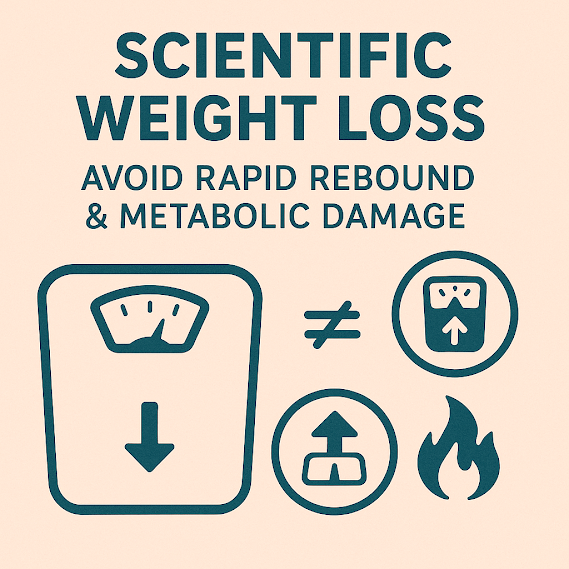Core Principles of Scientific Weight Loss
The foundation of scientific weight loss lies in sustainability and a health-first approach, avoiding rapid rebound or metabolic damage. Below is a systematic method based on medical guidelines and nutritional research:
I. Foundational Logic: Caloric Balance & Metabolic Protection
Moderate Caloric Deficit
- Daily intake should be 300-500kcal less than expenditure (excessive deficits trigger "starvation mode," slowing metabolism).
- Formula:
BMR (Basal Metabolic Rate) × Activity Factor × 0.8–0.9 = Recommended Daily Intake
Calculate BMR using the Mifflin-St Jeor equation.
Avoid Extreme Dieting Pitfalls
- Prolonged intake below 1,200kcal/day (women) or 1,500kcal/day (men) leads to muscle loss and hormonal imbalances.
- Aim for 0.5–1kg/week weight loss (1kg fat ≈ 7,700kcal deficit).
II. Dietary Strategies: Nutrient Density First
1. Macronutrient Balance
- Protein: 1.2–1.6g/kg body weight (preserves muscle, enhances satiety).
Sources: Chicken breast, fish, legumes, low-fat dairy. - Carbohydrates: Choose low-GI foods (stabilizes blood sugar, prevents cravings).
Sources: Oats, brown rice, sweet potatoes, whole-grain bread. - Fats: 20–30% of total calories (prioritize unsaturated fats).
Sources: Nuts, olive oil, avocado, fatty fish.
2. Fiber & Micronutrients
- Aim for 25–30g dietary fiber/day (supports gut health, reduces hunger).
- Supplement Vitamin D, B-complex, and calcium (critical for metabolism; prevents hair loss and fatigue).
3. Eating Rhythm Optimization
- 16:8 Intermittent Fasting: Limit eating to an 8-hour window (e.g., 12:00–20:00).
- Avoid Food 3 Hours Before Bed: Reduces nighttime fat synthesis.
III. Exercise Plan: Resistance + Cardio Combo
1. Resistance Training (Build Muscle, Boost Metabolism)
- 3–4 sessions/week, 30–45 minutes each.
- Focus on compound movements: squats, deadlifts, bench presses.
- 1kg muscle gain ≈ 50kcal/day increase in resting metabolism.
2. Cardio (Fat-Burning Efficiency)
- Low-Intensity Steady-State (LISS): Brisk walking, swimming (45–60 minutes, optimal fat oxidation).
- High-Intensity Interval Training (HIIT): Short, intense bursts (20 minutes/session, time-efficient).
3. Non-Exercise Activity Thermogenesis (NEAT)
- Stand more, climb stairs, do chores (burns 200–400kcal/day extra).
IV. Behavioral & Psychological Science
Cognitive Interventions
- Track meals with apps like MyFitnessPal.
- Set SMART goals (e.g., "Lose 2kg and 3cm waistline in 4 weeks").
Stress & Sleep Management
- High cortisol promotes abdominal fat; prioritize 7–9 hours of sleep.
- Practice meditation/deep breathing (obesity correlates with 30% higher stress hormones).
Sustainable Habit Formation
- Use "habit stacking": Reward workouts with 10 minutes of leisure.
- Allow 1 weekly "cheat meal" to prevent burnout.
V. Medical Monitoring & Adjustments
Key Metrics Tracking
- Body fat % (not BMI), waist-to-hip ratio, blood markers (glucose, lipids).
- Tools: Body fat scale, measuring tape, blood pressure monitor.
Combat Metabolic Adaptation
- For plateaus (>3 weeks):
- Try carb cycling (alternate high/low calorie days).
- Boost NEAT (e.g., walk 5,000 extra steps/day).
- For plateaus (>3 weeks):
Special Populations
- Insulin Resistance: Prioritize low-GI carbs + high fiber.
- Hypothyroidism: Treat underlying condition before diet changes.
VI. Pitfall Prevention Guide (Common Myths)
- ✘ Cutting all carbs (causes hair loss, amenorrhea, mood swings).
- ✘ Overusing meal replacements (nutrient deficiencies, high rebound risk).
- ✘ Spot reduction (fat loss is systemic; muscle toning enhances shape).
- ✘ "Sweat suits" (lose water, not fat).
VII. Sample Fat-Loss Meal Plan (~1,500kcal)
| Breakfast | Boiled eggs (2) + oatmeal (30g) + blueberries |
| Snack | Greek yogurt (100g) + walnuts (3) |
| Lunch | Grilled chicken breast (150g) + brown rice (80g) + broccoli |
| Dinner | Steamed fish (120g) + mixed grain porridge + spinach salad |
VIII. Long-Term Maintenance
- Post-goal: Increase intake by 100–200kcal/month, monitor weight.
- Maintain 2–3 resistance sessions/week (prevents muscle loss).
- Reassess metrics every 3 months.
Data Support
- China Obesity Prevention and Control Blue Book: Weekly loss ≤1% of body weight.
- Harvard Medical School: Combined resistance + cardio yields 35% better fat loss than single-mode exercise.
- WHO Guidelines: ≤25g added sugar/day; saturated fats ≤10% of total calories.
Scientific weight loss is lifelong health management, not a short-term sprint. Customize plans based on individual factors (genetics, lifestyle) and consult a nutritionist/doctor when needed.










Comments
Post a Comment